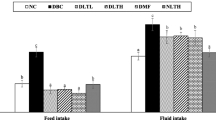Abstract
Bitter gourd (Momordica charantia), a commonly consumed vegetable is used as an adjunct in the management of diabetes mellitus. A study was carried out to examine the effect of edible portion of bitter gourd at 10% level in the diet in streptozotocin induced diabetic rats. To evaluate the glycaemic control of bitter gourd during diabetes, diet intake, gain in body weight, water intake, urine sugar, urine volume, glomerular filtration rate and fasting blood glucose profiles were monitored. Water consumption, urine volume and urine sugar were significantly higher in diabetic controls compared to normal rats and bitter gourd feeding alleviated this rise during diabetes by about 30%. Renal hypertrophy was higher in diabetic controls and bitter gourd supplementation, partially, but effectively prevented it (38%) during diabetes. Increased glomerular filtration rate in diabetes was significantly reduced (27%) by bitter gourd. An amelioration of about 30% in fasting blood glucose was observed with bitter gourd feeding in diabetic rats. These results clearly provided experimental evidence that dried bitter gourd powder in the diet at 10% level improved diabetic status signifying its beneficial effect during diabetes.
Similar content being viewed by others
Abbreviations
- BFC:
-
Bitter gourd fed control
- BFD:
-
Bitter gourd fed diabetic
- GFR:
-
Glomerular filtration rate
- SFC:
-
Starch fed control
- SFD:
-
Starch fed diabetic
References
Garau C, Adeghate I, Cummings E, Singh J (2003) Beneficial effects and mechanism of action of Momordica charantia in the treatment of diabetes mellitus. Int J Diabetes and Metab 11: 46–55.
Cummings E, Hundal H, Wackerhage H, Hope M, Adeghate E, Singh J (2004) Momordica charantia fruit juice stimulates glucose and amino acid uptakes in L6 myotubes. Mol Cell Biochem 261: 99–104.
Grover JK, Yadav SP (2004) Pharmacological actions and potential uses of Momordica charantia; a review. J Ethanopharmacol 93: 123–132.
Platel K, Srinivasan K (1995) Effect of dietary intake of freeze dried bitter gourd (Momordica charantia) in streptozotocin induced diabetic rats. Nahrung 39: 262–268.
Chandarshekar B, Mukerjee B, Mukerjee SK (1989) Blood sugar lowering potentiality of selected Cucurbitaceae plants of Indian origin. Ind J Med Res 90: 300–305.
Karunanayake EH, Jeevathayaparan S, Tennekooon KH (1990) Effect of Momordica charantia fruit juice on streptozotocin-induced diabetes in rats. J Ethnopharmacol 199–204
Ahmed I, Cummings E, Adeghate E, Sharma AK, Singh J (2004) Beneficial effects and mechanism of action of Momordica charantia fruit juice in the treatment of streptozotocin-induced diabetes mellitus in rats. Mol Cell Biochem 26: 63–70
Trowell HC (1975) Dietary fibre hypothesis of the etiology of diabetes mellitus. Diabetes 24: 762–765.
Bieri JG, Stoewsand GS, Briggs GM, Phillips RW, Woolard JC, Knapka JJ (1997) Report of the American Institute of Nutrition Adhoc Committee on standards for nutritional studies. J Nutr 107: 1340–1348.
Hugget ASG, Nixon DA (1957) Use of glucose oxidase, peroxidase and O-dianisidine in the determination of blood glucose and urinary glucose. Lancet 273: 366–370.
Miller GL (1959) Use of dinitrosalicylic acid reagent for determination of reducing sugar. Anal Chem 31: 426–428.
Folin O, Wu H (1919) A system of blood analysis. J Biol Chem 38: 81–110
Yokozawa T, Chung HY, He LQ, Qura H (1996) Effectiveness of green tea tannin on rats with chronic renal failure. Biosci Biotech Biochem 60: 1000–1005.
Rasch R, Mogensen CI (1980) Prevention of glomeruopathy in streptozotocin induced diabetic rats by insulin treatment. Diabetologia 18: 413–416.
Plaami SP (1997) Content of dietary fibre in food and its physiological effects. Food Rev Intl 13: 29–76.
Nandini CD, Sambaiah K, Salimath PV (2003) Dietary fibers ameliorate decreased synthesis of heparan sulphate in streptozotocin induced diabetic rats. J Nutr Biochem 14: 203–210.
Chethankumar M, Rachappaji KS, Nandini CD, Sambaiah K, Salimath PV (2002) Modulatory effect of butyric acid—a product of dietary fiber fermentation in experimentally induced diabetic rats. J Nutr Biochem 13: 522–527.
Seyer-Hansen K (1977) Renal hypertrophy in experimental diabetes relation to severity of diabetes. Diabetologia 13: 141–143.
Christiansen JS, Gammelgaard J, Frandsen M, Parring HH (1981) Incresed kidney size, glomerular filtration rate and renal plasma flow in short term insulin dependent diabetics. Diabetologia 20: 264–267.
Feldt-Rammussen B, Hegedus L, Mathiesen ER, Deckert T (1991) Kidney volume in type 1 (insulin dependent) diabetic patients with normal or increased urinary albumin excretions: Effect of long-term improved metabolic control. Scand J Clin Lab Invest 51: 31–36.
Wolver TMS, Jenkins DJA (1986) Effect of dietary fibre and foods on carbohydrate metabolism. In: Spiller GA (ed), CRC Handbook of Dietary Fibre in Human Nutrition. Florida: CRC Press, Inc., pp. 87–119.
Berggren AM, Bjorck IME, Nyman EMGL, Eggum BO (1993) Short chain fatty acids content and pH in caecum of rats given various sources of carbohydrates. J Sci Food Agric 63: 397–404.
Bourquin LD, Titgemeyer EC, Garleb KA, Fahey GC (1996) Fermentation of various dietary fibre sources by human fecal bacteria. Nutr Res 16: 1119–1131.
Baldwa VS, Goyal RK, Bhandari CM, Pangaria A (1976) A clinical trial of insulin obtained from the vegetable source (plant insulin) in patients with diabetes mellitus. Rajasthan Med J 16: 54–59
Shibib BA, Khan LA, Rahman R (1993) Activity of Coccinia indica and Momordica charantia in diabetic rats: Depression of the hepatic gluconeogenic enzymes glucose-6-phosphatase and fructose-1,6-bisphosphatase and elevation of both liver and red-cell shunt enzyme glucose-6-phosphate. Biochem J 292: 267–270.
Akhtar MS, Akhtar MA, Yaqub M (1981) Effect of Momordica charantia on blood glucose level of normal and alloxan diabetic rabbits. Planta Medica 42: 205–212.
Khanna P, Jain SC, Panagariya A, Dixit VP (1981) Hypoglycaemic activity of polypeptide-p from a plant source. J Nat Prod 44: 648–655.
Author information
Authors and Affiliations
Corresponding author
Rights and permissions
About this article
Cite this article
Shetty, A.K., Kumar, G.S., Sambaiah, K. et al. Effect of Bitter Gourd (Momordica charantia) on Glycaemic Status in Streptozotocin Induced Diabetic Rats. Plant Foods Hum Nutr 60, 109–112 (2005). https://doi.org/10.1007/s11130-005-6837-x
Issue Date:
DOI: https://doi.org/10.1007/s11130-005-6837-x




